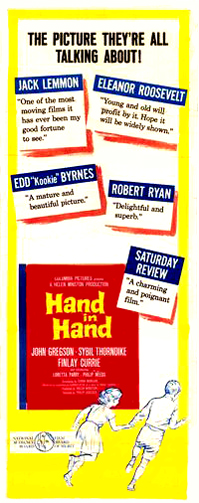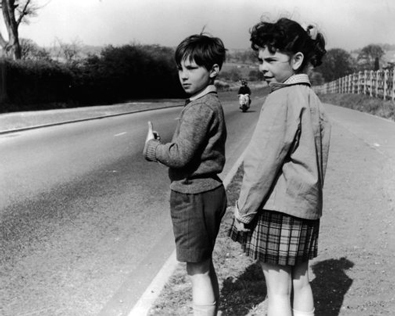
 |
|
|
|
The English Leacock brothers followed complimentary paths in filmmaking. Richard became an experimental documentarian, studied under Robert Flaherty and pioneered cinema vérité in the 1960s in a partnership with Donn Pennebaker. He was the cameraman on such notable films as Don't Look Back and Monterey Pop. Older brother Philip Leacock helped make pro-Republican documentaries on the Spanish Civil War front, and served with a British Army film unit during World War II. From there he transitioned into public service films about people in crisis. One of these was Life in Her Hands, starring Kathleen Byron (of Powell & Pressburger's Black Narcissus) as a nurse. Philip then made his name in more than a dozen socially conscious feature dramas, many of them involving children: The Kidnappers, Escapade, Innocent Sinners. Small children act out the tensions they see around them in the adult world, often because they are neglected or misunderstood. In Escapade the children of an anti-war activist disappear. The father (John Mills) is too caught up in his causes to pay attention to them; it turns out that they're carrying out a protest of their own. 
1960's Hand in Hand is a gentle picture that advances a social message of religious tolerance. Nine year-old Michael O'Malley (Philip Needs) is a happy Catholic boy. He enjoys a good relationship with his neighborhood priest, Father Timothy (John Gregson of Battle of the River Plate). Seven year-old Rachel Mathias (Loretta Parry) is an equally well-adjusted Jewish girl who sings a solo at a school assembly. When some bullies tease Rachel, Philip comes to her aid and a close friendship begins. Taking a cue from a TV show, they prick their fingers to become 'blood brothers', and promise to travel to Africa together. Rachel wants to have tea with the Queen, so the children try to hitchhike on the roadway. They're picked up by the wealthy Lady Caroline (Sybil Thorndike), who treats them to tea at her house. Trouble comes when a schoolboy tells Philip that Rachel is a Jew and that the Jews killed Christ. Discovering that they belong to mutually exclusive faiths, the children test the bond of their friendship by attending each other's religious services. Philip is comforted by a positive message in the ceremony at the synagogue, while Rachel decides that a statue of the Virgin Mary "likes her". Having defeated the twin taboos that separate them, the children hurry to fulfill their second wish -- by taking a tiny rubber raft down the river to "go to Africa". Hand in Hand is an endearing little story of children vs. intolerance. Although clearly meant to charm its audience, it derives its tension by placing Michael and Rachel in one vaguely dangerous situation after another. The kids are allowed to wander off totally unsupervised. They set up a little playhouse in an abandoned shack, hitchhike out on the main road and carry a rubber raft through town without anybody raising an eyebrow. The movie will remind any parent that nobody feels safe letting their children out of their sight these days. Perhaps the writers Diana Morgan and Sidney Harmon were influenced by René Clément's classic Forbidden Games, a much more pessimistic look at the secret emotional lives of children. Director Leacock elicits natural performances from his young actors. It was common at the time to replace children's voices with tracks by expert English dubbing artists, but it is difficult to tell in this picture as the scenes and playing are so natural. Philip Needs' Michael is a little gentleman and Loretta Parry's Rachel a happy little girl with an almost impossibly bright smile; neither strikes a false note. Michael shows his affection by giving Rachel his pet mouse. When it dies, he insists on a makeshift Catholic service. As soon as Michael's back is turned Rachel secretly recites a Hebrew verse and declares, "You were a Jewish mouse!" Hand in Hand places its children in a reasonably harmonious neighborhood, where the Priest and the Rabbi (Derek Sydney) can pause on the street to argue about football matches. The religious divide is expressed without ever being fully explained. Philip is shocked when his classmate claims that, "Rachel killed Christ". The kid says that his father doesn't like Jews, and then adds that he doesn't like Catholics either. Philip wanders off in a daze, angry that Rachel would hide such a crime from him. A critic might find fault that the relatively benign situation allows Philip to weigh the problem in a reasonable manner; Hand in Hand's message might not have been very effective in, say, a Northern Irish town where the first thing a child learns is to hate neighbors of different faiths. Hand in Hand's setting is also free of class tensions. It's a far cry from the downtrodden working-class slums of Bryan Forbes' harrowing allegory Whistle Down the Wind, starring Hayley Mills. That movie is also about small children acting out confused fantasies, but they end up disillusioned and traumatized. 
There's nothing condescending in the fact that the message of Hand in Hand is suitable for tiny tots. God loves us whether we're Jewish or Christian. The movie doesn't resolve Rachel and Philip's future friendship -- which doesn't look too likely considering that she's moving away -- and it doesn't try to resolve religious differences or the problem of bigotry. Philip tells Rachel that his mother (Kathleen Byron) agreed with the bully that the Jews killed Christ, but we doubt that she said it in just that way. Philip is obviously too immature to handle the whole story. Asked if her daughter's friendship is getting too serious, Mrs. Mathias isn't concerned: "We won't have to worry about that problem for ten years or so." "Let's just hope she finds a nice Jewish boy like me", says her father. In other words, neither family is likely to invite the other over for tea. Hand in Hand carries credits for religious advisors of both faiths. Although the film doesn't pretend that the differences are minor, it makes a point of demystifying Jewish and Christian services for young viewers, and showing that neither faith constitutes a threat. The film acts on the idea that the forming of positive social attitudes needs to be done gently when children are young. That might make it propaganda of a sort, but that conclusion doesn't take into account the mountains of films seen by children that celebrate violence and promote anti-social attitudes. Hand in Hand is an honest little film that backs its good intentions with solid values. 
Philip Leacock keeps his camera down at the eye-level of his charming and capable young stars. Released by Columbia Pictures in the United States, Hand in Hand saw Leacock undertake a major career change away from his long run of intimate, socially conscious films. He went on to work with Steve McQueen on the eccentric aviation combat picture The War Lover. In 1963 he began filming for American television, and continued to work on TV series for the next thirty years. Actress Sybil Thorndike is given a high slot on the cast list for her brief part as the generous Lady Caroline, and Finlay Currie receives third billing even though his role amounts to four brief lines. He's an elderly newsagent who never even leaves his chair. Sony's release of Hand in Hand proves that it hasn't totally abandoned older films on standard DVD. The crisp, flawless B&W image displays a fine range of grays. Freddie Young (Lawrence of Arabia) was the director of photography, and every shot of this modestly budgeted film is very handsome, particularly the close-ups of the children.
On a scale of Excellent, Good, Fair, and Poor,
Hand in Hand rates:
Reviews on the Savant main site have additional credits information and are often updated and annotated with reader input and graphics. Also, don't forget the 2010 Savant Wish List. T'was Ever Thus.
Review Staff | About DVD Talk | Newsletter Subscribe | Join DVD Talk Forum |
| ||||||||||||||||||